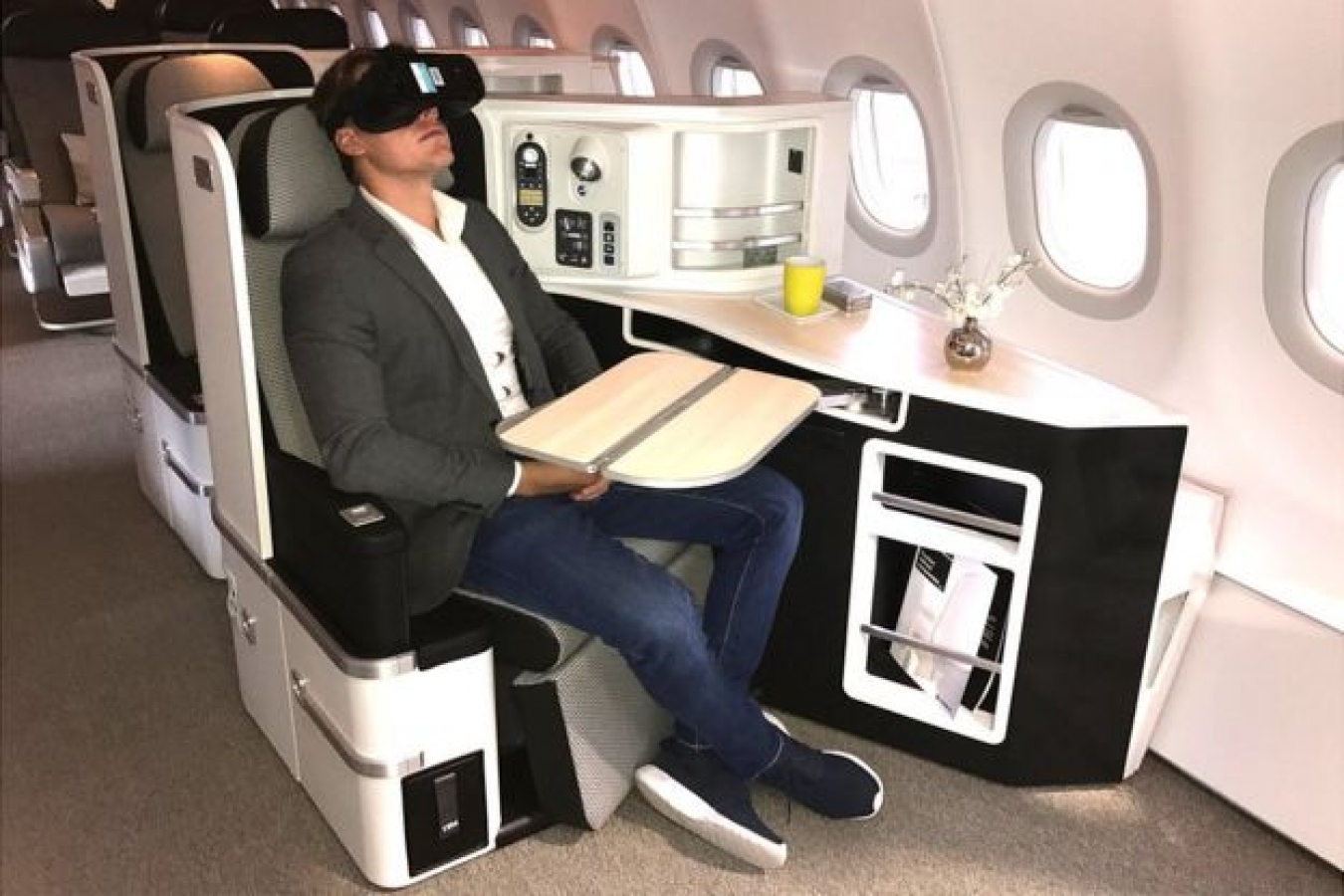


 12:8:36
12:8:36  2018-03-26
2018-03-26  1968
1968

By: Matthew Wall, BBC Technology
Finnish start-up Varjo has developed a prototype virtual reality (VR) headset that its makers claim gives an image 50 times sharper than most other headsets currently on the market.
When I tested the prototype - looking round the virtual cockpit of a passenger plane - the level of detail in the small central area of vision was certainly impressive - as close to the real thing as I've come across.
Image quality outside this area, simulating standard VR headsets, was noticeably fuzzier.
Founder and chief executive Urho Konttori says the firm has managed to achieve this by mimicking how the eye sees.
"The human eye only focuses on a thumbnail-sized area of vision - the brain fills in the rest," he says. "Our peripheral vision is less detailed, at a much lower resolution."
So Varjo's headset provides very high definition images only of the objects our eyes are focusing on at any particular moment, the rest of the scene is at lower resolution. It uses eye-tracking technology to tell which parts of the image it needs to render in high definition.
-----
-----
This technique is known as foveated rendering within the industry - chipmaker Nvidia has been working on it for a few years.
This selective approach uses a lot less computing power, says Mr Kontorri - roughly 25% less than current VR headsets.
But this level of detail doesn't come cheap - headsets will cost between €5,000 and €10,000 (£4,350 and £8,700) - so the Helsinki-based firm is targeting corporate customers, such as aircraft manufacturers, carmakers, architects, construction firms and the entertainment industry.
"VR visualisation - looking at designs of cars, buildings, cityscapes in high-definition 3D - will become a key part of the design process for business," says Brian Blau, VR analyst for research firm Gartner.
Mr Kontorri, who used to work for Microsoft and Nokia, is hoping that simulator training for aircraft pilots and other professionals could be made a lot cheaper using VR in addition to training on traditional full-scale simulators.
"Fully functional cockpit simulators can cost around €10m so there aren't many around, and access to them is limited," he says. "Using our system could bring the total cost of training to around €100,000."
Carmakers BMW, Audi and Volkswagen have all asked for early access to the technology so they can help develop the prototype, says Mr Kontorri. And aerospace firms Saab and Airbus have also expressed interest. Game development platforms Unreal and Unity are technical partners.
But of course, a prototype is not the same as a final product.
Varjo, which has attracted more than $15m (£11m) in funding so far, is aiming to bring a final version to market by the end of 2018.
And rivals are exploring a similar approach.
Chipmaker Qualcomm, for example, has teamed up with eye-tracking firm Tobii to develop headsets that concentrate graphical processing power to where the user is looking.
The image quality of the peripheral vision is reduced without the user noticing.
-----
"There is definitely a market for high-end virtual reality," thinks Tom Mainelli, an VR specialist at market intelligence firm IDC.
"In fact, we're seeing an increasing demand from commercial entities that want higher-resolution hardware to drive more immersive experiences in everything from employee training to product design to manufacturing."
But so far, it's fair to say VR has had an image problem - in more ways than one.
Picture quality on most consumer headsets has suffered by comparison with today's high-resolution smartphone and TV screens, while slow frame rates have often contributed to feelings of nausea among users watching fast-moving content.
This is also caused by latency - when you move your head and the image lags behind slightly.
"This causes your eyes, inner ear, and brain to get out of sync," says Mr Mainelli.
Faster graphics chips can help address this issue, he says, "but the content must address it, too. If a VR experience has lots of jump cuts outside the control of the user it can also cause discomfort, regardless of the frame rate or low latency."
Tailoring content to suit the environment will be crucial for airlines looking to offer more immersive entertainment for their passengers, says Moritz Engler, co-founder of Munich-based start-up Inflight VR.
-----
"On a plane you can't have people making sudden head movements and potentially hitting other passengers," he says. "You have to make sure the content is appropriate."
This means avoiding content involving roller-coaster rides or fighter plane dogfights.
"The last thing we want is for passengers to get sick," he says.
Inflight VR has developed a platform to manage and distribute suitable content for airlines and has been trialling its service with Spanish carrier Iberia, amongst others. Airlines could offer commercial services as well as entertainment, Mr Engler believes.
"Say you're flying to the Maldives, you could watch a film about scuba diving and then book a course, or you could go virtual shopping during the flight," he says.
Another obvious drawback with VR is the inconvenience of having to put on a clunky headset that can become uncomfortable after prolonged use.
-----
VR headset makers are beginning to address all these issues.
For example, HTC is releasing its Vive Pro headset in April, which features a much higher-resolution screen, high-performance headphones with noise cancellation facility, and a more comfortable strap. It will cost £799.
Users will also be able to unplug the headset from the computer and move freely thanks to a wireless dongle accessory.
Pimax has even produced a headset with ultra high-definition 8K image resolution and a 200 degree field of view (humans can see 220 degrees without having to move our heads).
Cheaper headsets - think Samsung's Gear - use your smartphone as the screen, but new products such as Facebook's Oculus Go and Lenovo's Mirage Solo will "eliminate the need for a phone or PC altogether," says Mr Mainelli.
"These products will drive a much different experience and will ship in notable volumes this year."
So VR for business has a long way to go if it's to catch up with the consumer gaming market. About 20 million headsets were sold in 2017, says Mr Blau, but the business sector accounted for less than 5% of that.
"The problem with VR is that people think they're going to get a movie-quality experience, but the technology can't match that yet."
It seems that higher-definition images, faster chips and lighter headsets can't come fast enough.
Reality Of Islam |
|

A large inf

Choosing th

A new NURBS

A research
 9:3:43
9:3:43
 2018-11-05
2018-11-05
10 benefits of Marriage in Islam
 7:5:22
7:5:22
 2019-04-08
2019-04-08
benefits of reciting surat yunus, hud &
 9:45:7
9:45:7
 2018-12-24
2018-12-24
advantages & disadvantages of divorce
 11:35:12
11:35:12
 2018-06-10
2018-06-10
 6:0:51
6:0:51
 2018-10-16
2018-10-16
 8:4:21
8:4:21
 2022-01-08
2022-01-08
 8:21:9
8:21:9
 2018-06-21
2018-06-21
 2:5:14
2:5:14
 2023-01-28
2023-01-28
 2:11:12
2:11:12
 2022-10-15
2022-10-15
allah will not answer all your prayers
 6:56:28
6:56:28
 2022-01-01
2022-01-01
 1:16:44
1:16:44
 2018-05-14
2018-05-14
 4:26:43
4:26:43
 2022-02-21
2022-02-21
 5:41:46
5:41:46
 2023-03-18
2023-03-18
| LATEST |